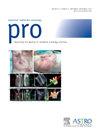Quality and Safety Considerations for Radiopharmaceutical Therapy in the Radiation Oncology Environment: An ASTRO Safety White Paper
IF 3.5
3区 医学
Q2 ONCOLOGY
引用次数: 0
Abstract
Purpose
Radiopharmaceutical therapy (RPT) is the latest topic in a series of white papers published by ASTRO addressing quality processes and patient safety. The availability of radiopharmaceutical agents for therapeutic use has broadened patient treatment options; although generally administered systemically, their effects are targeted to cellular receptors or the tumor microenvironment. Radiation oncology is well suited to delivering RPT because clinicians are already experienced in radiation safety, treatment delivery, and ongoing patient care. This paper focuses on the logistics of initiating and/or maintaining an RPT program in radiation oncology and includes collaborating with other medical specialties. The white paper addresses the safety processes and workflow considerations for alpha- and beta-emitting radionuclides used for RPT.
Methods
ASTRO convened a multidisciplinary task force, composed of experts from radiation oncology, nuclear medicine, medical and health physics, to provide consensus on key workflows and processes for RPT. Recommendations were created using a consensus-building methodology and task force members indicated their level of agreement based on a 5-point Likert scale, from “strongly agree” to “strongly disagree.” A prespecified threshold of ≥75% of raters who select “strongly agree” or “agree” indicated consensus. Content not meeting this threshold was removed or revised.
Summary
Establishing an RPT program in radiation oncology requires specific infrastructure for receiving, storing, preparing, and administering radiopharmaceuticals by staff with expertise in specific infusion methods. RPT cases benefit from a multidisciplinary approach led by a radiation medicine physician and authorized user with support from additional personnel trained in RPT. A comprehensive quality management program must be developed to comply with applicable regulations and standards, including the handling of radioactive materials. Participation in incident reporting and external audits of a practice’s overall quality assurance processes is encouraged. Using the guidance provided, authorized users can assess the viability of starting an RPT program, develop the necessary infrastructure, and sustain a safe, high-quality RPT program that includes radiation oncology.
放射肿瘤学环境中放射药物治疗的质量和安全考虑:ASTRO安全白皮书。
目的:放射药物治疗(RPT)是ASTRO发表的一系列关于质量过程和患者安全的白皮书的最新主题。治疗用放射性药物的供应扩大了病人的治疗选择;虽然通常是全身给药,但它们的作用是针对细胞受体或肿瘤微环境的。放射肿瘤学非常适合提供RPT,因为临床医生在放射安全、治疗提供和持续的患者护理方面已经有了经验。本文的重点是在放射肿瘤学中启动和/或维持RPT项目的后勤,包括与其他医学专业的合作。白皮书阐述了用于RPT的α -和β -发射放射性核素的安全流程和工作流程考虑因素。方法:ASTRO召集了一个由放射肿瘤学、核医学、医学和健康物理学专家组成的多学科工作组,就RPT的关键工作流程和流程达成共识。建议是用建立共识的方法提出的,工作组成员根据5分李克特量表表明他们的同意程度,从“非常同意”到“非常不同意”。选择“非常同意”或“同意”的评分者的预设阈值≥75%表示一致。不符合此阈值的内容已被删除或修改。摘要:在放射肿瘤学中建立RPT计划需要由具有特定输注方法专业知识的工作人员提供接收、储存、制备和管理放射性药物的特定基础设施。RPT病例受益于由放射医学医师和授权使用者领导的多学科方法,并得到接受过RPT培训的其他人员的支持。必须制定全面的质量管理计划,以符合适用的法规和标准,包括放射性物质的处理。鼓励参与事件报告和实践整体质量保证过程的外部审计。使用所提供的指导,授权用户可以评估启动RPT计划的可行性,开发必要的基础设施,并维持包括放射肿瘤学在内的安全,高质量的RPT计划。
本文章由计算机程序翻译,如有差异,请以英文原文为准。
求助全文
约1分钟内获得全文
求助全文
来源期刊

Practical Radiation Oncology
Medicine-Radiology, Nuclear Medicine and Imaging
CiteScore
5.20
自引率
6.10%
发文量
177
审稿时长
34 days
期刊介绍:
The overarching mission of Practical Radiation Oncology is to improve the quality of radiation oncology practice. PRO''s purpose is to document the state of current practice, providing background for those in training and continuing education for practitioners, through discussion and illustration of new techniques, evaluation of current practices, and publication of case reports. PRO strives to provide its readers content that emphasizes knowledge "with a purpose." The content of PRO includes:
Original articles focusing on patient safety, quality measurement, or quality improvement initiatives
Original articles focusing on imaging, contouring, target delineation, simulation, treatment planning, immobilization, organ motion, and other practical issues
ASTRO guidelines, position papers, and consensus statements
Essays that highlight enriching personal experiences in caring for cancer patients and their families.
 求助内容:
求助内容: 应助结果提醒方式:
应助结果提醒方式:


